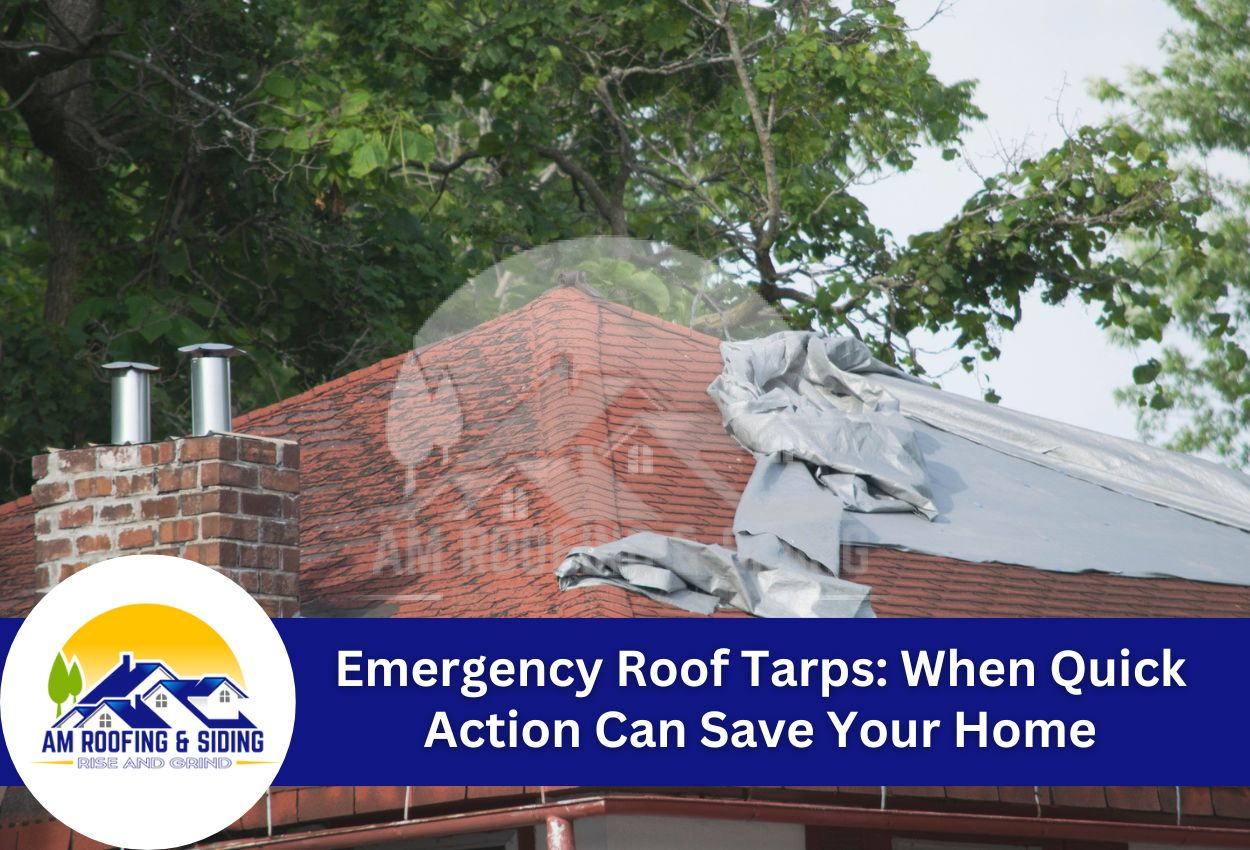When unexpected roof damage strikes, taking immediate action can mean the difference between minor repairs and extensive home restoration. Emergency roof tarps serve as the critical first line of defense when your roof has been compromised, especially during Central Ohio’s unpredictable weather. These temporary protective barriers prevent water infiltration, structural damage, and interior destruction while you await professional repairs.
Roofing emergencies in Central Ohio often result from severe thunderstorms, high winds, fallen trees, or heavy snow accumulation. These situations create vulnerable points where water can enter your home, leading to ceiling damage, insulation saturation, electrical hazards, and even mold growth. The window between initial damage and professional repairs is when emergency roof tarps are the most valuable.
Understanding when to use emergency roof tarps is essential for every homeowner. Temporary protection installed promptly after storm damage can prevent thousands of dollars in additional repairs. Whether you’re facing missing shingles, punctures from fallen debris, or more substantial structural damage, temporary roof protection during severe weather provides the time needed to arrange for permanent solutions. Professional roofing contractors can properly secure these protective coverings to ensure they remain effective until repairs can be done.
Situations That Require Immediate Roof Tarping
Recognizing when to apply an emergency roof tarp can prevent extensive damage to your Central Ohio home. Severe thunderstorms, which frequently roll through our region during spring and summer, often create conditions that necessitate immediate protection. After storms pass, inspect your property for missing or lifted shingles, visible holes, or granules collected in gutters, which are all clear indicators that water can enter your roof system.
High winds exceeding 50 mph can tear away roofing materials even without other storm elements present. When these winds are accompanied by hail, the damage becomes more concerning. Hail leaves distinctive circular impact marks and cracks that compromise your roof’s waterproof integrity, making emergency roof tarp installation after storm damage essential before the next rainfall.
Several non-storm scenarios also warrant immediate tarping. Fallen tree limbs that puncture or scrape roofing materials create entry points for water. Sudden leaks appearing on ceilings or walls during rainfall indicate damage requiring temporary roof protection. Even aging roofs approaching the end of their service life may develop unexpected failures before replacement is scheduled.
Preventing water damage with emergency roof tarps is especially crucial when you notice water stains expanding on interior ceilings or walls, as these signal active leaks that will worsen without intervention.
The Benefits of Prompt Roof Tarping After Damage
When your roof sustains damage, swift action through emergency tarping brings both protection and financial benefits. Temporary roof tarps create a crucial barrier that shields your home from the elements while permanent repair plans are developed. For Central Ohio homeowners facing roof damage, properly installed tarps provide immediate protection against our region’s unpredictable rain, snow, and wind. Signs you need an emergency roof tarp before repairs include visible holes, missing shingles, interior water stains, or any situation where precipitation could enter your home.
Emergency roof tarp installation after storm damage prevents secondary destruction throughout your home. Without this protective covering, water can infiltrate your attic space, saturating insulation and reducing its effectiveness. This moisture then typically spreads to ceilings, wall cavities, and electrical systems, potentially creating fire hazards and costly repairs. Personal belongings stored in attics or upper floors remain protected when tarps are properly secured, preventing thousands in additional losses.
Insurance companies view emergency roof tarping favorably when processing claims. By demonstrating responsible damage mitigation and temporary roof protection during severe weather, you fulfill your obligation as the policyholder to prevent unnecessary secondary damage. Before covering damaged areas, document everything thoroughly with dated photographs and videos showing all compromised sections from multiple angles. This evidence can be used during claim processing and helps ensure maximum coverage for your permanent repairs.
DIY Emergency Roof Tarping vs. When to Call Pros
When facing roof damage, homeowners must quickly decide whether to handle emergency tarping themselves or call professionals. This decision impacts both immediate protection and long-term outcomes for your home.
For DIY emergency tarping, homeowners need several essential items: a heavy-duty tarp that is larger than the damaged areas, lumber for securing edges, cap nails or screws, safety ropes, a ladder with stabilizers, and personal protective equipment including non-slip footwear and a harness. Safety must be the priority — never attempt roof work during active storms, high winds, or when temperatures create slippery conditions. Roofs with steep pitches (beyond 4:12) significantly increase fall risks and are better left to professionals.
Professional emergency roof tarp installation offers significant advantages, particularly for extensive damage. Many Central Ohio roofing contractors provide rapid response teams equipped with commercial-grade materials and specialized equipment for safely working on compromised structures. These professionals use specific securing techniques that prevent tarp failure during subsequent storms, properly wrapping and anchoring tarps to maintain protection until permanent repairs begin. Professional services also include thorough damage documentation that supports insurance claims and a comprehensive assessment of underlying issues that might not be visible to untrained eyes.
How Long Can You Safely Leave a Roof Tarp in Place
Emergency roof tarps are designed as temporary solutions, but their effective lifespan varies based on a few different factors. Most standard tarps can reliably protect your home for 30 to 90 days, though higher-quality materials may extend this timeframe. Polyethylene tarps, commonly used for emergency coverage, typically withstand Ohio’s conditions for about 30 to 60 days before showing signs of degradation. Heavy-duty reinforced tarps with UV protection can sometimes last 90 to 120 days, offering extended protection through a season.
Ohio’s seasonal weather presents specific challenges for tarped roofs. Summer heat and intense UV exposure can accelerate deterioration, causing tarps to become brittle and crack. Fall brings falling debris that may puncture protective coverings, while winter’s freeze-thaw cycles and snow buildup stress tarp attachment points. Spring winds can work loose edges that were previously secure. Warning signs that your tarp is failing include visible tears or holes, sagging sections where water pools, loosening at secured edges, or interior leaks despite the tarp’s presence.
Regular inspection of your emergency roof tarp is essential for maintaining protection. Check attachment points weekly and after any significant weather event. Clear debris promptly to prevent pooling water and reduce unnecessary weight. When you notice deterioration beginning, contact a professional roofing contractor immediately rather than attempting to extend the tarp’s lifespan with patches or additional layers. Remember that tarps are emergency measures, not long-term solutions for your Central Ohio home.
From Temporary Fix to Permanent Solution: The Transition Process
Moving from an emergency roof tarp to a permanent roof repair requires careful planning and a professional assessment. For Central Ohio homeowners, understanding this transition process helps manage expectations and ensures your roof’s integrity is restored. The timeline for this transition varies based on the damage, material availability, and seasonal weather patterns.
In best-case scenarios with minimal damage and favorable weather, the transition from tarp to repair might take just two weeks. However, more extensive damage typically requires up to four weeks for proper assessment, ordering materials, and scheduling. During peak storm seasons when many Central Ohio homes need repairs simultaneously, this timeline can extend to six to eight weeks as roofing contractors manage high demand. Winter presents additional challenges, as certain roofing materials require minimum temperatures for proper installation, potentially delaying permanent repairs until warmer conditions return.
Assessing the damage beneath the tarp is necessary for creating repair plans. Experienced roofers carefully remove sections of the tarp to examine the full extent of damage, including hidden issues that weren’t apparent during emergency tarping. This thorough inspection identifies compromised decking, water-damaged insulation, and affected structural elements that might be concealed beneath surface materials. Using moisture meters and infrared technology, professionals can detect water infiltration patterns that help determine the true scope of necessary repairs, ensuring that when the tarp comes off, the solution is truly permanent rather than a superficial fix.
Preparing for Roofing Emergencies Before They Happen
Being proactive about roof protection can significantly reduce the impact of unexpected damage to your Central Ohio home. While emergency roof tarps provide essential protection after damage occurs, thoughtful preparation can minimize the need for these temporary measures in the first place. Planning preventive upkeep helps maintain your roof’s integrity year-round.
Central Ohio experiences distinct seasonal threats to roofing systems. Spring brings heavy rains and wind, summer delivers intense storms and heat, fall introduces more debris, and winter brings snow and ice. Schedule professional inspections two times per year to identify minor issues before they become emergencies. Regular maintenance should include gutter cleaning, trimming back overhanging branches, replacing damaged shingles, and checking flashing around chimneys and vents.
Creating a roof emergency plan before problems arise ensures you’ll respond effectively when needed. Keep emergency supplies, including a properly sized heavy-duty tarp, securing materials, safety equipment, and application instructions. Have contact information for trusted roofing contractors readily available, including their emergency response capabilities. Document your roof’s current condition with dated photographs to establish a baseline for insurance purposes. When signs you need an emergency roof tarp appear, having these preparations in place can mean the difference between minor repairs and major restoration.
Emergency Roof Tarp Services by AM Roofing & Siding
When facing severe weather or unexpected roof damage in Central Ohio, knowing when to use emergency roof tarps is crucial to protect your home. AM Roofing & Siding specializes in rapid-response tarping services that prevent water damage and safeguard your property until permanent repairs can be made. Our expert team is equipped to handle any emergency, so your roof is securely covered, no matter the weather conditions.
If you’re unsure whether your situation requires an emergency roof tarp, call us immediately at (740) 974-8268. Don’t wait until it’s too late — prevent further damage to your home by securing professional tarp installation after storm damage. Trust AM Roofing & Siding to provide fast and effective solutions with our emergency roof tarp services.

